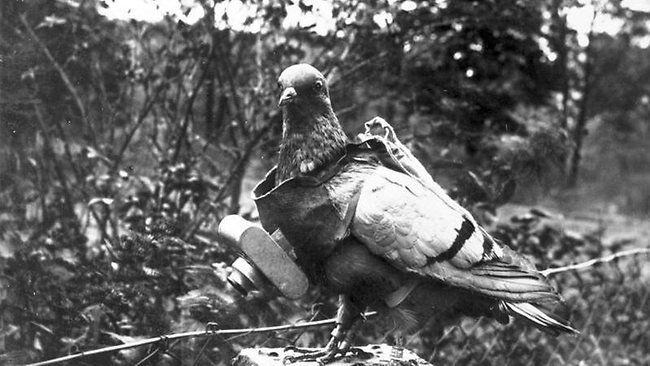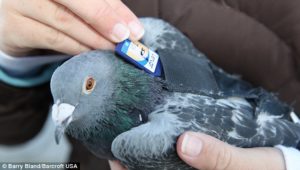So, you know that little term “internet protocol” (IP), yes? It’s kind of the “glue” that holds together all that we do as video conferencing and unified communication professionals. Well, having been in the software and IT industry since Windows 95 was being shipped on 20+ floppy disks, and a military aviator for 10 years, I’ve been looking into ways I can meld my two worlds into one. The obvious question for me is, why aren’t we giving this IP over Avian Carriers (IPoAC) more of a solid shot?
I mean, come on! It would be hilarious. Can you imagine your boss’s face when you present this as a viable alternative?
To help you construct your (hopefully fake) proposal I’d like to provide some insights so you can best optimize the end-user experience for IPoAC. Should you decide to give it a go due to mind-blowing levels of frustration, or as a joke, feel free to use the following to support the success of your IPoAC program.
IPoAC Backstory
So, I’ve been digging into this IP of Avian Carriers thing, and it’s ridiculous. More often than not, it’s a playful jab at the quality of service found on overtaxed or substandard network implementations.
Serious question: for large 4k video files, would it sometimes be faster and cheaper to have a bird carry the data? #IPoAC
— the DJ, MTCade (@LeMTCade) April 28, 2015
@maustermuhle I see you’re familiar with #IPoAC https://t.co/snJdOe279A See also, #sneakernet pic.twitter.com/X9fCQZXmcm
— Bilsko (@Bilsko) May 23, 2016
However, it also has a time and place.
Pigeons equipped with internet-connected BACKPACKS, track air pollution in #London@PigeonAir #AirPollutionhttps://t.co/dwfgtWq9B0
— IN THE NOW (@IntheNow_tweet) March 22, 2016
This all makes me want to adopt a bunch of carrier pigeons and head to the roof right now and start experimenting.
Apparently, IPoAC has been successfully implemented. However, resources indicate “success” means things like nine packets of data are transferred, with a packet loss ratio of 55% due to user error, and a response time ranging from 3000 seconds (~54 minutes) to over 6000 seconds (~1.77 hours). If your packet loss or latency is this bad on your current network then we may need to talk (over a traditional landline or cell phone of course).
Naturally, being the nerd that I am, I started to think about just how impractical this type of media delivery is, and the o-so-obvious drawbacks for our typical, day-to-day needs. I work in the world of video conferencing, so, of course, I immediately understand how such a medium would be limited to carrying one-way conversations and soliloquies over IPoAC (by the way I have never witnessed such one-sided behavior over video…but I digress). Oh, and what about the level at which network security would be compromised? Woah.
In addition to the previously mentioned caveats, any network implemented as IPoAC for any real-time applications such as VC must also address the two most prevalent technical obstacles to a quality end user experience: packet loss and jitter.
Impacts of Packet Loss on Quality
Packet loss can manifest itself in various ways in video streams. Modest, and especially momentary packet loss rates can easily be compensated for within most video codec algorithms. Sustained and larger packet loss rates will force more radical codec compensation and result in blurry video with lower refresh rates. Once packet loss exceeds what can be compensated for within the codec being utilized, the result will be more dramatic effects such as massive screen pixelation mixed with possible screen freezes and eventually a call disconnect could result.
There are many factors that could prevent your packet carrying birds from reaching their destination with your precious audio and video packets: illness, injury, getting lost, aircraft collisions, hunting season, and Bubba hunting outside of hunting season.
Packet Loss Mitigation:
- Birds should be well ‘homed’ and be trained on the specific route over which they are going to travel.
- Packet redundancy is recommended above all for applications such as VC where high packet loss must be avoided. Therefore birds should carry redundant of packets carried by other birds.
- Carrier birds must be highly motivated to arrive at their destination, so feeding should always occur immediately after packet delivery takes place at the delivery (the bird’s home site).
- Should a flock be required to spend more than 12 hours off site a moderate feeding should be provided to ensure strength to complete the flight. Birds that are weak or overly hungry have been found to deviate from the flight path, and though they will eventually arrive with their precious cargo, they will arrive after the TTL has expired and thus these will be considered lost packets.
- Packet carrying equipment should light, reliably secure the load and also be designed to withstand the elements that may occur in route (wind, rain, heat, etc.).
Impact of Jitter on Quality
Jitter in video streams is highly recoverable at reasonable levels that are non-sustained. However, jitter on the audio channel tends to manifest itself more readily as a ‘person talking underwater’ sound.
Jitter Mitigation:
There are many factors that could result your packet carrying birds reaching their destination out of order, thus producing jitter. The most controllable factors are mitigated below.
- A nearly uniform flock should be maintained with regards to bird species, size, and age. Much stronger flyers mixed with weaker flock members will result in a jittery transmission of packets.
- Likewise, payload weight and aerodynamic resistance should be nearly equal across all packet carriers. Preferably, all equipment affixed to each bird should be identical despite potential variations in actual packet loads carried.
- Should an offsite feeding be provided, uniformity of feeding rations is critical to maintaining packet order. Uncontrolled ration delivery close to flight time can radically alter weight and flight fitness uniformity across the flock. In short, heavy, overfed birds fly slower than their more lightly fed cohorts.
If you have completed this blog post and you still have further questions regarding IPoAC, I would recommend giving it your best effort and then sharing your findings over more conventional medium such as ethernet, fiber, token ring, EoP, [fill in the blank]. As for us here at Vyopta, we have moved on to more immediate tasks, such as extracting downy fibers from our SD card slots.







